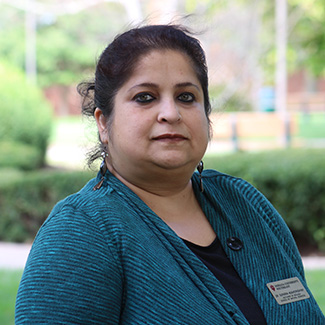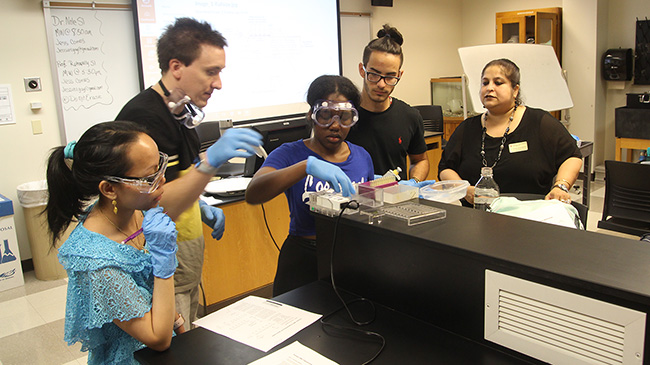 Suparna Mukhopadhyay
Suparna MukhopadhyayLecturer in Biology
School of Natural Sciences
By Steven Krolak
(NEW ALBANY, Ind.)— “You can put me anywhere, and I can teach it,” said Suparna Mukhopadhyay, lecturer in biology.
With her universal expertise and can-do spirit, Mukhopadhyay blends the micro and the macro to give students the tools they need to both master the technical aspects of their field and become well rounded individuals equipped to succeed in the workplace.
Along the way, her devotion to involving first-year students in scientific research makes her classes both innovative and impactful.
“I don’t want them to memorize,” Mukhopadhyay said of her students. “I inspire them to do things that will make them think.”
Into the deep end
Last year Mukhopadhyay received a grant from the Bill and Melinda Gates Foundation and the American Association of State Colleges and Universities (AASCU) to implement a unique proposal for high-impact practices (HIP) in first year courses.
The project gave first-year students in L102 (Evolution, Ecology and Species Diversity) the opportunity to work with specimens from the IU Southeast Fish and Mussel Collection.
These native fish—over 60 species—were collected in the Blue River, a tributary of the Ohio River, in the 1970s by IU Southeast instructors Dr. Claude Baker and Dr. Bill Forsyth. They were never systematically assessed or catalogued. As curator of the collection, Mukhopadhyay saw an opportunity for students to perform real research, and opened the metal cabinet doors wide.
In giving students access to the collection, Mukhopadhyay was tossing them into the deep end.
Given only the specimen, its species name and the location of its capture, the students established the current ecological distribution, phylogeny and taxonomy, and took photos for inventory, cataloguing and digitization. They gathered information on feeding and mating habits, changes in range over time, and migration patterns.
These and other data points filled papers and posters, students knowing that they had performed the first documentation of these animals, and showing their enthusiasm via quantity and quality of work that went above and beyond the assignment.
The project did more than meet the definition for a high impact practice as one that involves students in original research as early in their college careers as possible.
It gave them the satisfaction of having contributed something tangible to the field.
For Mukhopadhyay, the student response was a validation of her own persistence, as well as a contribution to theirs.
A willingness to innovate
Mukhopadhyay knows the deep end well. because she has been tossed into it, many times. And always she has embraced the plunge as an opportunity to grow.
The result of this growth is a career path that can best be described as a unity of paradoxes: it is both highly idiosyncratic and highly targeted. A mile wide and a mile deep. Attuned to the importance of the long game and willing to seize upon serendipitous opportunities.
Throughout her career, her willingness to innovate has been her most reliable survival strategy in moving steadily forward, and this willingness is what she seeks to impart to her students. She teaches as she has lived, steadily accruing new skills and applying them in across an exceedingly broad range of expertise..
In her native India, as one of three sisters in a family devoted to education, she earned a bachelors degree in zoology with a minor in chemistry and botany, then a masters in zoology with concentrations in genetics and environmental biology.
Her education in India was extremely broad-based. At the masters level, for example, her degree encompassed taxonomy, biochemistry, molecular biology, evolution, ecology, genetics, anatomy and physiology.

Dr. Suparna Mukhapadhyay (r) supervises first-year students learning to master basic lab techniques. Mukhopadhyay’s commitment to innovation is coupled with a dedication to fundamental skills.
Coming to the U.S. in 1996, she received her Ph.D. at the University of Louisville in the field of molecular genetics, cloning the gene for night blindness in mice for her thesis. She then conducted post-doctoral research into the molecular genetics of lung cancer.
Then came another plunge into the unfamiliar: she accepted an offer for a research administrative position, becoming a research evaluator for Kentucky’s nascent informatics infrastructure network. In this capacity she investigated the work of 40 faculties at eight state universities and prepared comprehensive reports for, among others, the National Institutes of Health.
Craving interaction with people and missing the academic life, she gave up her well-paying position for an uncertain future in teaching, beginning with a class in anatomy at Jefferson Community and Technical College in Louisville. She had subject matter expertise, but no teaching experience—another dive into the deep end fueled by hope, bolstered by confidence, and rewarded with certitude.
“That one semester teaching anatomy completely changed my life,” Mukhopadhyay said. “I totally saw that it was my calling.”
As a visiting professor at IU Southeast, she created her fully online course in animal nutrition—the first course of its kind in the IU system, and one that would enable IU Southeast preveterinary majors complete their degrees here and not have to go to Purdue for this one final requirement.
Mukhopadhyay received a Strategic Excellence grant from IU to create this course, and as part of the grant requirement, she joined the online cohort with the Institute for Learning and Teaching Excellence (ILTE) to make sure the course met university standards for online instruction. Once she had created the course, it was peer reviewed by ILTE. The course has been a great success, and has spurred Mukhopadhyay to introduce students in her other face-to-face courses to more advanced technology, including Launchpad, for which she also organized a training session for other faculty with the publisher.
In fall 2017, Mukhopadhyay finally found her teaching home at IU Southeast when she was named lecturer in biology.
Tradition as innovation
Despite her embrace of the new, Mukhopadhyay’s pedagogical credo is not exactly radical.
“My teaching philosophy embraces fairness, challenge, enthusiasm and service,” Mukhopadhyay said.
In fact, looking at a list of her instructional tactics, it’s easy to see why Mukhopadhyay refers to herself as “a traditional teacher”: study guides, closed-book tests, time limits, punctuality.
Students can earn extra credit on critical thinking questions, or participate in hands-on lab experiments, to gain marks by other means than testing, such as the unique projects she has designed in every course, and Mukhopadhyay reaches out to all students ad hoc to relate more realistically to their individual learning needs.
But before any of that can take place, Mukhopadhyay insists upon an absolute dedication to the building blocks of the craft of science.
In a lab during the fall semester, you can see that dedication being built, painstakingly and persistently: Students learn to use a micro pipette to load a protein sample in a gel for molecular analysis. This is an essential technique that lab scientists carry out, without thinking, many times a day. It becomes routine, if not banal, but at the beginner level, it can be as nerve-wracking as a tightrope-walk over the Grand Canyon.
To convey the usefulness of the task and introduce a sense of fun, Mukhopadhyay frames the exercise as a game of Clue: a forensic riddle in which there are five suspects, and five samples, one of whom is the culprit. It is up to the students, using simple DNA Fingerprinting lab techniques, to nab the perp.
Motivating students to learn
Underlying everything Mukhopadhyay does in the classroom is a humility about her own expertise and willingness to learn from students.
“Just because I have a Ph.D. doesn’t mean I know everything,” Mukhopadhyay said.
As a result, Mukhopadhyay is not one to impose a paradigm for innovation, but to be open to where her students’ inquiring minds may lead her.
Once at home in the solitude of labs and spreadsheets, Mukhopadhyay has become an educator of the whole person, helping students think critically and pursue opportunity.
“The most effective style adopted by a professor while teaching a particular course cannot be pre-formulated,” Mukhopadhyay said. “As a professor, I primarily try to understand the students and to find out what motivates them to learn.”


